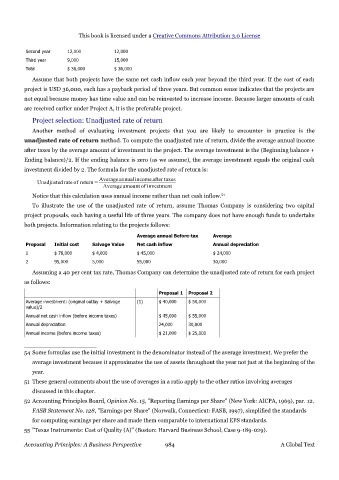Page 983 - Accounting Principles (A Business Perspective)
P. 983
This book is licensed under a Creative Commons Attribution 3.0 License
Second year 12,000 12,000
Third year 9,000 15,000
Total $ 36,000 $ 36,000
Assume that both projects have the same net cash inflow each year beyond the third year. If the cost of each
project is USD 36,000, each has a payback period of three years. But common sense indicates that the projects are
not equal because money has time value and can be reinvested to increase income. Because larger amounts of cash
are received earlier under Project A, it is the preferable project.
Project selection: Unadjusted rate of return
Another method of evaluating investment projects that you are likely to encounter in practice is the
unadjusted rate of return method. To compute the unadjusted rate of return, divide the average annual income
after taxes by the average amount of investment in the project. The average investment is the (Beginning balance +
Ending balance)/2. If the ending balance is zero (as we assume), the average investment equals the original cash
investment divided by 2. The formula for the unadjusted rate of return is:
Average annualincome after taxes
Unadjusted rate of return=
Average amount of investment
Notice that this calculation uses annual income rather than net cash inflow. 54
To illustrate the use of the unadjusted rate of return, assume Thomas Company is considering two capital
project proposals, each having a useful life of three years. The company does not have enough funds to undertake
both projects. Information relating to the projects follows:
Average annual Before-tax Average
Proposal Initial cost Salvage Value Net cash inflow Annual depreciation
1 $ 76,000 $ 4,000 $ 45,000 $ 24,000
2 95,000 5,000 55,000 30,000
Assuming a 40 per cent tax rate, Thomas Company can determine the unadjusted rate of return for each project
as follows:
Proposal 1 Proposal 2
Average investment: (original outlay + Salvage (1) $ 40,000 $ 50,000
value)/2
Annual net cash inflow (before income taxes) $ 45,000 $ 55,000
Annual depreciation 24,000 30,000
Annual income (before income taxes) $ 21,000 $ 25,000
54 Some formulas use the initial investment in the denominator instead of the average investment. We prefer the
average investment because it approximates the use of assets throughout the year not just at the beginning of the
year.
51 These general comments about the use of averages in a ratio apply to the other ratios involving averages
discussed in this chapter.
52 Accounting Principles Board, Opinion No. 15, "Reporting Earnings per Share" (New York: AICPA, 1969), par. 12.
FASB Statement No. 128, "Earnings per Share" (Norwalk, Connecticut: FASB, 1997), simplified the standards
for computing earnings per share and made them comparable to international EPS standards.
55 "Texas Instruments: Cost of Quality (A)" (Boston: Harvard Business School, Case 9-189-029).
Accounting Principles: A Business Perspective 984 A Global Text

